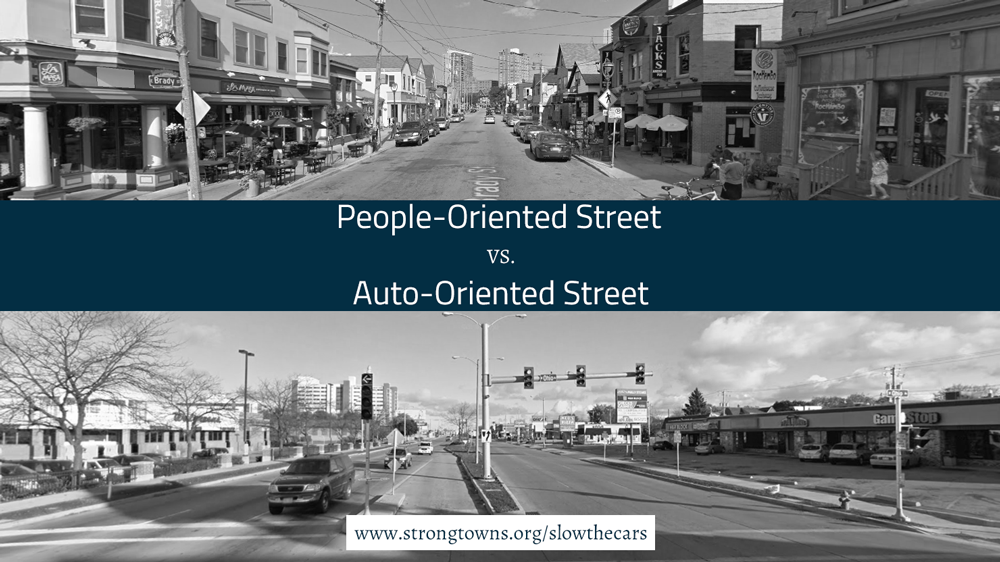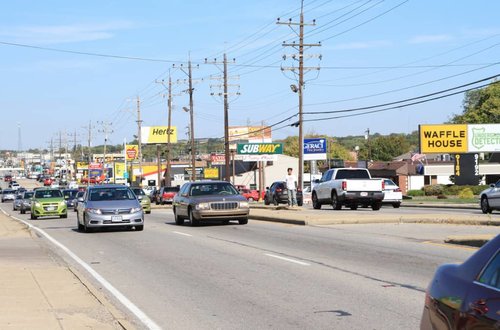You know those games you usually find on the back of a cereal box or in a kids’ magazine that present you with two seemingly identical pictures and ask you to spot the six things that are different in each? Well, here’s a much easier version of that:

What differences can you spot in the pictures above? (Hint: There are more than six.)
We’re going to talk a little about those differences today and why understanding them is so crucial if we wish to build financially successful cities and towns.
What does auto-oriented mean?

An auto-oriented street is, quite simply, one built primarily for cars. Highways are obviously auto-oriented, but so are most of the streets and stroads in our cities.
Here’s a handy checklist to help you tell whether a street is built mostly for cars:
- Are there multiple lanes of traffic in each direction?
- Are the lanes of traffic considerably wider than the average car?
- Do most of the businesses along the street provide their own parking lots?
- Is there a large distance between the street and the businesses or homes lining the street (because of parking, landscaping, etc.)?
- Are the intersections controlled with traffic signals?
- Does the street lack sidewalks?
If you answered yes to one or more of the above questions, you’re looking at an auto-oriented street.
The good news is that there are plenty of fairly simple, affordable ways to begin to move an auto-oriented stroad in the direction of becoming a people-oriented street. Stay tuned for those later this month.
What does “walkable” or “people-oriented” mean?
A people-oriented street is welcoming, safe and accessible for people in all forms of transportation but especially on foot. The buildings, sidewalks and other features are all scaled to people, not cars.

Here’s a checklist that will help you identify a people-oriented street:
- Does the street have no more than one lane of traffic in each direction?
- Are the lanes narrow (not much wider than the average car)?
- Is parking either directly on the street or behind the buildings?
- Are the homes and businesses close to the street with amenities (like signage and windows) sized for people?
- Would it be relatively safe and feasible for a person to cross the street at any point, including the middle of the block?
- Are there sufficient sidewalks?
- Are there people out on the street? (No, seriously; is there even a single human being?)
If you can answer yes to several (and ideally all) of the questions above, you’re likely on a people-oriented street. The last question is perhaps the most telling indication of a people-oriented street. If you were to visit this street on a nice day, you should see a ton of people walking its sidewalks, visiting its businesses on foot, etc.
The good news about designing people-oriented streets is that they work better for everyone — not just people walking. First, they make life safer for everyone because they require everyone to be more attentive to their surroundings and to travel at slower speeds. Second, despite concerns that narrowing a street will reduce its car capacity and make a car trip through it take a lot longer, this is often not the reality. In fact, many streets, when narrowed, allow for the same amount of traffic to pass through and travel times may even end up being similar — especially if signalized intersections are eliminated in favor of slower speed options like roundabouts, stop signs and uncontrolled intersections. That’s because, on a typical stroad, you drive 40+ mph for a few seconds and then you’re forced to come to stop after stop at massive, multi-way intersections. On a narrow, slow street, you can maintain a more consistent speed. (More on this topic.)
A people-oriented street is not anti-car. Quite the contrary. A people-oriented street is pro-people — whether the people are walking, biking or driving.
A Word of Caution
If there’s one thing you should take away from this discussion of walkable streets, it’s the necessity of narrowing many of our roadways (items 1 and 2 on our checklists). The other features mentioned above — on-street parking, sufficient sidewalks etc. — are all fairly meaningless if you don’t have narrow streets. It can actually be harmful to invest in these sorts of features if you don’t also narrow the streets around them, because you’re sending the mixed message to people that a) they should walk there, but b) it won’t actually be safe for them to do so because cars will be driving too fast. Not to mention it’s a waste of municipal funding to build a beautiful new sidewalk that no one is actually going to use because it’s dangerous and unpleasant.
Why does it matter?
So why does building people-oriented streets instead of only car-oriented streets matter? It’s not only because they’re safer or because they enable people to get around affordably without a car. It’s also — and chiefly — because they are more economically productive. They encourage local business activity, produce more tax value per acre and offer a better return on infrastructure investment. Learn more about why walkable streets are more economically productive.
This is a guest blog post by Rachel Quednau at Strong Towns.